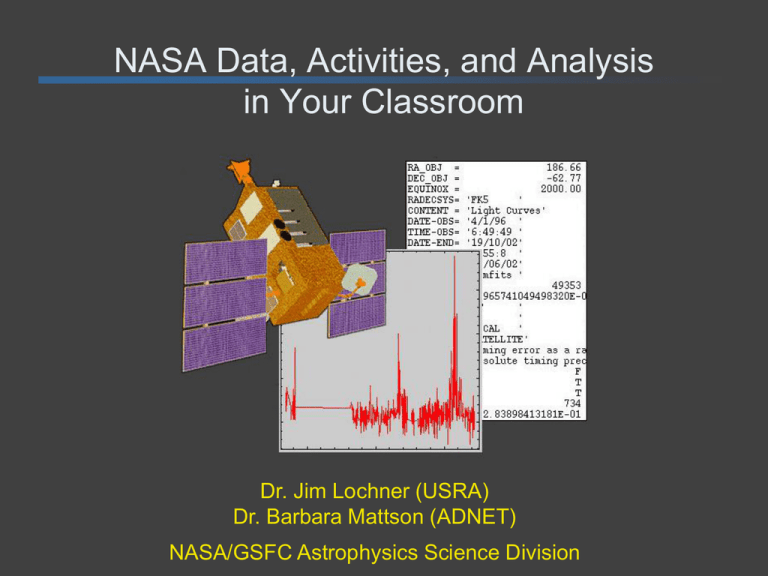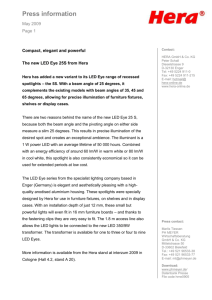NASA Data, Activities, and Analysis in Your Classroom Dr. Jim Lochner (USRA)
advertisement

NASA Data, Activities, and Analysis in Your Classroom Dr. Jim Lochner (USRA) Dr. Barbara Mattson (ADNET) NASA/GSFC Astrophysics Science Division Astronomy in the Classroom What if you could explore pulsars, binary stars, and black holes in your classroom? What if your students could work with the same astronomical data and software that scientists at NASA use? Connect to classroom using NASA Data Astronomy data analysis offers students: applications in science and math concepts opportunities to improve inquiry and research skills engagement in real-world problem solving an understanding of relationship between data and theory learning of concepts within an exciting context a connection with NASA and other institutions experience with what “real scientists” do Using data in the classroom shows that anyone can do “real science” – it’s not scary! NASA & Data NASA has petabytes of data from its satellites, manned exploration, and research programs 1 petabyte of information = approximately 50 times the size of the entire print collection of the U.S. Library of Congress Data is ever-growing with new missions – and with newer technology, data gets bigger Specialized data management has been created for NASA’s unique storage needs HEASARC & Data (High Energy Astrophysics Science Archive Research Center) HEASARC contains 16 terabytes of data from 26 satellite observatories The largest collection of X-ray and gamma-ray data on stars, black holes, pulsars, supernova remnants, and galaxies Astronomers from around the world download the data via Browse - Download volume equals size of the archive every 6 months Welcome to Student Hera! Student Hera brings real astronomy into the classroom! Students use the same software and methods as scientists to study objects in space such as black holes, pulsars, and binary stars. One small download brings the universe to your fingertips. What are Hera and Student Hera? Hera provides an interface to satellite data and analysis tools which are used by scientists. - Neither tools or data need to be downloaded to user’s local computer. Hera is used by scientists around the world. Student Hera is a scaled-down interface which provides selected data sets and tools for teachers and students. - Web pages provide tutorials of the analysis for students. Astronomy Data & Analysis Timing - Measure how the intensity of X-rays from an object varies with time - Stars, Binary Star Systems, Black Holes, Pulsars Imaging - See where the X-rays are coming from - Supernova Remnants, Clusters of Galaxies Spectroscopy - Measure the energy of the X-rays - Stars, Binary Systems, Black Holes, Supernova Remnants, Galaxies, etc. Tutorial #1: Timing Objective: determine the period of a binary star system - System contains a pulsar and a normal star Students make predictions for what the orbit looks like Students estimate period by plotting the light curve Students obtain period using a Chi-squared analysis technique Students compare shape of light curve and compare with their predictions Studying pulsars with HERA Looking at objects with an Xray telescope can teach us about their structure, features, and behavior. Pulsars are neutron stars (very small, dense stars) that “pulse” with radiation through the rotation of intense magnetic fields. Observing these pulses can teach us about the rotation, period, and other features of the pulsar! GX301-2 GX301-2 is an X-ray binary system -- a pulsar in orbit with a supergiant star. Mass is transferred from the supergiant to the pulsar. The more mass dumped onto the pulsar, the more X-rays it will emit. From the data, we can calculate the orbital period and determine the type of orbit. Light Curves and Periods A light curve is a graph which shows the brightness of an object over a period of time. In the study of objects which change their brightness over time, the light curve can help us determine the rotational period of an object, or the orbital period of two objects in a binary system! Estimating the Period By identifying the peaks in the light curve, you should be able to estimate the orbital period for the system. From this plot of 3000 rows, it looks like the peaks are around 40 days apart. The error in this estimate is quite large -- plus or minus 10 days (or more)! Determining the Period Light Curve Folded Light Curve What type of orbit does the light curve suggest? ? What type of orbit does this light curve suggest ? Orbital Properties of GX301-2 More Mass - More X-rays 41.5 d period in an eccentric orbit. Tutorial #2: Imaging Students search the image of a supernova remnant in different energy bands From gamma-ray data, they discover, as astronomers did, a new supernova remnant Tutorial #3: Spectroscopy Examine a supernova remnant - An exploded star and element “factory” Determine the elemental composition Students model the spectrum with continuous xray emission and spectral lines Supernova ! The End of the Road for Massive Stars Supernova Remnants Crab Nebula from SN 1054) Tycho’s SN (SN 1572) Kepler’s SN (SN 1604) SN 1987A Elements in Supernovae Explosive power of a supernova: • Disperses elements created in large stars. • Creates new elements, especially those heavier than Iron. All X-ray Energies Calcium Silicon Iron Spectrum of a Supernova Remnant The peaks are evidence of oxygen, neon, and magnesium in a supernova remnant. Modeling the Spectrum Scientists use mathematical models to describe spectra These are different than physical models that your students may be used to With a math model, astronomers (and students) can characterize processes that could not be observed by just looking at the spectrum Tutorial #4: Black Hole Spectroscopy Examine a black hole transient - Watch the matter falling into the black hole from from its neighbor Determine the speed of the matter falling into the black hole Students model the spectrum with continuous x-ray emission and spectral lines Using Student Hera It’s easy to get started with Student Hera in the classroom. The website leads you through installation and getting started. Student Hera requires one 10MB download from the website and an active internet connection. An installation wizard to guide you through set-up. Just click on the Student Hera icon on your desktop, and you’re ready to go! Student Hera Tutorials Student Hera Interface Student Hera offers a variety of tools and data to explore. From Tutorials to Research Once students have mastered the analysis techniques, they can expand analysis to other objects - Group or individual research projects - Science fair projects Tutorials parallel historical research done by scientists – results can be researched and verified in scientific literature Classroom uses for Student Hera Use software and exercises within lessons on related concepts, such as light curves, X-ray astronomy, or binary stars. Plotting tools can create useful visual aids! Assign students individual or group projects using Student Hera. Projects can be based on the guided activities on the website -- many variations are possible. Integrate into lessons on mission design and technology. Student Hera offers a look at the real data that comes back from satellites, as well as the specialized analysis and manipulation that scientists perform. Use with related lessons and activities from online learning resources such as Imagine the Universe! and mission-related sites like the RXTE Learning Center. College Hera Lab Timing Tutorial is also available as a 2-hour lab experience for 1st year college astronomy courses. - Guided web course tracks student progress and tests concept understanding - http://imagine.gsfc.nasa.gov/docs/teachers/hera_college/ - Developed by Dr. Beth Hufnagel, Anne Arundel Community College, Maryland New Ideas? How would you use Student Hera in your classroom? Check us out online! http://imagine.gsfc.nasa.gov/docs/teachers/hera/

